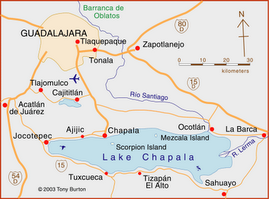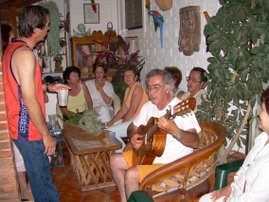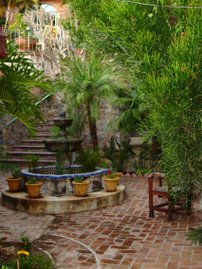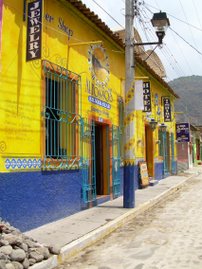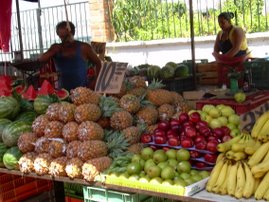I was talking to my brother, Fred, on the phone yesterday, complaining to him that I was concerned that I was beginning to run out of topics to put on the blog. I am aware of the fact that I don't want to get repetitive, and I DON'T want this blog to be, like so many others I've seen, a self-indulgent travel log, like an on-line series of postcards: "Having a great time, wish you were here!" Fred reminded me that what may be mundane to us is still foreign and interesting to him, and probably to others. I was also thinking I needed to put a certain number of photos with each post. Fred is visually impaired and can't see the photos, so he's more interested in the writing. I was confessing to Pearl Sawyer, one of our friends form the Auburn UU church that I wasn't writing much poetry yet. She suggested that my blog was the writing I was doing now. THEN I worry, who wants to read all this anyway? Of course, those who are not interested, won't bother. SOOOOOO...as this project is constantly morphing, I'm not sure where it's going, but I hope to make it interesting and, perhaps most of all, enable my friends and family to experience this wonderful country through my eyes, and not through the stereotypical, xenophobic lenses of mass media and popular myth.
One of the most interesting, and sometimes difficult, aspects of living in Mexico, of us, is the constant awareness that we are living outside of our element. We don't know the language well enough to have a normal conversation, we don't understand many aspects of the culture, and, quite honestly, we stick out like sore thumbs. This can be disconcerting. Many gringos here are constantly worried that we are being taken advantage of. Of course we are! We are bringing our money to spend, and the Mexicans, entrepreneurial spirits that they are, will try to figure out any angle they can to get some of the action. But this is part of the economic culture here. When I go to an area of Chapala or Guadalajara where there are few gringos, I see Mexicans selling anything they can think of to try to hustle other Mexicans. This is a culture where everyone is responsible for him or herself. That's partly why it is such a vibrant and energetic place. The gringo money here is yet another opportunity for people to get in on the action and improve their situation. Whether it's hawking watches or watermelon on the street, to giving out tastes of mango and cantaloupe in the market to get you to buy THEIR fruit, to driving gringos around showing them ridiculously high-priced real estate, they are responsible to make their lives better. As the foreign expats, WE are responsible for making good decisions about how we spend OUR money. If we get a bad deal, it's our tough luck. We should have been paying more attention. An example: Pixie and I saw a guy selling cherries on the street the other day. I asked Pixie if she wanted some, and she did. "Quanto?" I asked. Cinquenta (50) pesos for a half a kilo, cien (100) pesos for one kilo. Fruits and vegetable are always cheap, huh? So without thinking clearly, I said, "Medio kilo, por favor," handed over 50 pesos and took the bag of cherries. It wasn't until we were home that I realized we'd paid about $5 for a rather small bag of cherries. I figured it to be about 12 cents per cherry. Not really that cheap. Chalk one up for experience. Won't do that again.
Not speaking the language is a very obvious aspect of being in a foreign country. Although I can speak better Spanish than I did, it is very rough, and I know my pronunciation is not good. I have been studying the language on my own for about a year, though, and I can carry on a conversation reasonably well with people who speak little or no English. I just jump right in and give it a whack. Sometimes they look at me quizzically, and I know they missed whatever it was I was trying to say. Then I back up and rephrase, point, mime, or use some other cheap tactic to try to get my point across. Eventually they smile with an "aha" look and correct me. One of my favorite strategies is to point to something and say, "Que en Espanol, por favor?" (What is this in Spanish?) I get lots of free lessons that way. The two Mexican children who live on our property, Yoselin and Jesus are also very helpful. They speak no English, but are always dropping by to visit. They laugh hysterically when I say something wrong but are very nonjudgmental when they correct me. This is one of the aspects of living here I enjoy the most. I was always a poor language student in school, but here I'm somewhat successful, even though I'm probably just as bad!
One of the aspects of living here that is most difficult for me is the obvious difference in economic security between us and the Mexicans. Yoselin and Jesus have very little, as do their parents. They all live in a two-room house and earn $250 a month for providing gardening and maid service for the six houses here. The children are all well-dressed and very polite. Daniel and Dora, the parents, are always very helpful, work hard, and are always pleasant. We are retired, spend most of our day doing what we like, can afford a laptop computer and eating out in restaurants, live in a much larger and nicer house, and have them to do all the "dirty work" for us. I feel awkward sitting on the patio reading a book and sipping iced tea while Daniel weeds the garden and vacuums "our" pool. I know he's glad to have a job, etc. But I've always felt uncomfortable about the random advantages some people enjoy largely by being born in a certain place or with certain advantages. I am sure I feel more awkward about it than Dora or Daniel, or any of the countless Mexicans working in this community doing menial jobs to support their families. Menial work here is not looked down upon as in the US. Being a gardener, a maid, or a waiter are seen as respectable professions. It's my issue, and has been since I was a young Marxist in college!
Tuesday, July 31, 2007
Monday, July 23, 2007
Guadalajara
Right over the mountains from Lake Chapala is Mexico's second largest city, Guadalajara, home to 4.1 million people. (Mexico City, Mexico's largest city, has a population of 19.1 million, the largest in the Western Hemisphere). Checking on Wikipedia, I discovered that it was founded as an old colonial city in 1532, and still retains its historic center with some of the oldest colonial buildings in Latin America. It is also a large commercial, industrial, and cultural center as well as the capital of the state of Jalisco. A number of high tech corporations have built plants in the city as a result of NAFTA, and it is a major banking and economic center for the country. Culturally, it is quickly becoming the cultural center of Mexico. The Guggenheim foundation has approved the construction of the 6th museum in the world in Guadalajara, and it will be the tallest building in Latin America. Guadalajara will also host the 2011 Pan American Games.
For those of us who have chosen to live in the Lake Chapala area, Guadalajara is clearly one of the factors that makes this area so attractive. Miguel Hidalgo International airport, between Guadalajara and Lake Chapala, is about 40 minutes from Ajijic and has many connecting flights to Dallas, Houston, Atlanta and other American hubs daily. Flights from Boston are generally about $500, which makes it easy to return home for visits and for friends and family to visit us in Mexico. It also gives us access to excellent medical care which would not be as available in more remote areas of Mexico. Delcarmen and St. Javier hospitals are two of the finest hospitals in the country with many US-trained and English speaking doctors. I doubt that if it were not for the proximity to Guad (as local residents refer to it), we would have many fewer "northamericanos" living here.
There is also the opportunity for shopping in Guadalajara. Many Americans who live here are very concerned about having many of the products they are used to at home. As a result, many of these folks make regular trips into Guad to shop at Walmart , Sam's Club, Cotsco, and Home Depot, all available there. We have visited Walmart and Sam's Club and have, frankly, not been too impressed. Most of the products are Mexican, for Mexicans, and are easily available here in Ajijic or Chapala. There are some American products which are available, some in large quantities, which draws people there. The cost of some of these American items is cheaper at these stores than in the few stores near Lake Chapala which stock, and mark up, American imported products. As I've mentioned before, we tend to stick to mostly American products and don't mind spending a little extra for rare American products like Peanut Butter here in town. But the big box stores are so popular with some lakeside residents that they schedule bus trips just to Walmart and Sam's club for people who are not wild about driving in themselves.
Two of the most popular shopping districts of Guadalajara are Tlaquepaque and Tonala, the former being very tourist-friendly and more expensive. We drove into Tlaquepaque with a friend one day and had a chance to explore the area. There is a big pedestrian area with lots of shops and restaurants there, and it's fun to walk around, but the prices ARE high. Many of the pottery and glassware for sale is made in Tonala and is available there for much lower prices. We drove into Tonala by ourselves on Saturday and found it much more in our budget. We didn't buy much, but we'll be back, I'm sure.
Driving in Guadalajara is an adventure. Mexicans are mild mannered people, until they get behind the wheel. We have driven in three times so far, and I think I am figuring it out. It's definitely not for the fainthearted. Luckily, reliable bus service is cheap and easily available from Ajijic. We are looking forward to some interesting experiences in Guadalajara!
For those of us who have chosen to live in the Lake Chapala area, Guadalajara is clearly one of the factors that makes this area so attractive. Miguel Hidalgo International airport, between Guadalajara and Lake Chapala, is about 40 minutes from Ajijic and has many connecting flights to Dallas, Houston, Atlanta and other American hubs daily. Flights from Boston are generally about $500, which makes it easy to return home for visits and for friends and family to visit us in Mexico. It also gives us access to excellent medical care which would not be as available in more remote areas of Mexico. Delcarmen and St. Javier hospitals are two of the finest hospitals in the country with many US-trained and English speaking doctors. I doubt that if it were not for the proximity to Guad (as local residents refer to it), we would have many fewer "northamericanos" living here.
There is also the opportunity for shopping in Guadalajara. Many Americans who live here are very concerned about having many of the products they are used to at home. As a result, many of these folks make regular trips into Guad to shop at Walmart , Sam's Club, Cotsco, and Home Depot, all available there. We have visited Walmart and Sam's Club and have, frankly, not been too impressed. Most of the products are Mexican, for Mexicans, and are easily available here in Ajijic or Chapala. There are some American products which are available, some in large quantities, which draws people there. The cost of some of these American items is cheaper at these stores than in the few stores near Lake Chapala which stock, and mark up, American imported products. As I've mentioned before, we tend to stick to mostly American products and don't mind spending a little extra for rare American products like Peanut Butter here in town. But the big box stores are so popular with some lakeside residents that they schedule bus trips just to Walmart and Sam's club for people who are not wild about driving in themselves.
Two of the most popular shopping districts of Guadalajara are Tlaquepaque and Tonala, the former being very tourist-friendly and more expensive. We drove into Tlaquepaque with a friend one day and had a chance to explore the area. There is a big pedestrian area with lots of shops and restaurants there, and it's fun to walk around, but the prices ARE high. Many of the pottery and glassware for sale is made in Tonala and is available there for much lower prices. We drove into Tonala by ourselves on Saturday and found it much more in our budget. We didn't buy much, but we'll be back, I'm sure.
Driving in Guadalajara is an adventure. Mexicans are mild mannered people, until they get behind the wheel. We have driven in three times so far, and I think I am figuring it out. It's definitely not for the fainthearted. Luckily, reliable bus service is cheap and easily available from Ajijic. We are looking forward to some interesting experiences in Guadalajara!
Sunday, July 15, 2007
Cost of Living in Ajijic
One of the appeals for the migration of retirees to Mexico and other Latin American locales is the cost of living. However, as places like Ajijic become more prosperous and populated by more Americans and Canadians, the cost of living inevitably rises. So the question becomes, is it really cheaper to live in this area of Mexico? The answer is yes...and no.
Perhaps the most noticeable high cost of living here is housing. Many of the ads in the real estate ads are selling houses in the $250-300,000 USD range. This is because many wealthy American, Canadian, and Mexican developers have figured that there is a market for these homes, usually built on the mountainside with a view of the lake, and separate from where most of the people live. Many US retirees who have sold expensive homes in the US can afford to pay cash for these houses. It's really not much different from Maine or anywhere else. Where there is wealth, there will be expensive homes.
But these ads are a bit misleading. There are homes in the Lake Chapala area in all price ranges. Because there are very low property taxes in Mexico, usually $50-100 per year, people are not as much in a hurry to sell, and prices are often higher than the property is worth. Overall, I'd say property in Ajijic is equivalent to what we would find in Maine, although I have seen decent properties for under $100,000 advertised in Chapala and Jocotepec.
Rentals vary as well. Pixie and I are enjoying our rental and the fact that we don't have the hassles of home ownership. Many people here rent. We know people who rent small but very nice places in Chapala for about $300 a month. Our beautiful lake front cottage in Ajijic is $700 a month. For $600-700 a month, it seems one can find very nice rentals almost anywhere. Of course we also see rentals advertised for $1500 a month as well. In terms of housing, you can pay as much or as little as you want, but overall, it's certainly not dirt cheap.
I won't discuss medical care because I covered it in my last post. It is a significant expense of living here, although cheaper than the US.
Food is very economical, IF you buy Mexican and local products. We shop for food in several places. First, we got to the outside market (called the Tiangas) every Wednesday. There we typically buy things like fruit (mangoes, pineapples, limes, melons, apples, strawberries, bananas) and vegetables (zucchini, beans, broccoli, lettuce, tomatoes, nopale--edible cactus--, and peppers). Usually we buy about $5-6 dollars worth which gets us through most of the week. We buy locally made yogurt (unusual flavors--celery pineapple, carrot orange, strawberry walnut-- ALL good-- for about $1.50 for a half liter). We buy fresh fish (brought in every morning from the Pacific, NOT Lake Chapala!), usually red snapper, for about $4.00 for a serving for two. (You pick the fish, and he fillets it for you). Huge shrimp are available for about $8.00 a kilo--2.2 lbs.) Bread is available for about 50 cents a loaf. Granola is available in bulk for about $2 a kilo. We also buy a bunch of fresh flowers for the house each week for about $3-4 for a large bouquet. You can also buy household goods, electrical supplies, batteries, and clothing at the market. We usually spend about $30 there.
We also shop as small neighborhood stores which are everywhere. We tend to buy our milk, eggs, tortilla chips, beverages, soap and other miscellaneous items from these local merchants. One nice thing here is that you can buy whatever you need: one egg, two small rolls, one small bottle of white glue, one piece of wrapping paper. I love fresh corn tortillas which I buy from a local tortillaria. I usually ask for 5 pesos worth ($.50) which gives me 20 or so tortillas which last a week or more. I heat them on the tortilla heater which our stove is equipped with.
We do have a few supermarkets which sell many other products, but not always cheaper than the local merchants, surprisingly. We tend to buy things like olive oil, which is harder to find at these local shops for a good price, at these larger stores. We go to them less than we did however, as we discover local resources. American products are available for a premium price.
Pixie loves plants, of course, and this is plant -lovers paradise! We have slowly been picking up plants, mostly in big ceramic pots (so we can take them with us if we move) for very reasonable prices. Typically large tropical plants like the ones illustrated here, cost about $5-8, and the large ceramic pots cost $7-12. We've been picking up about one each week. It's fun, because we know we can leave them out all year, and it gives our home a more tropical look. As you can see, Pixie has a good eye for this.
Here are what we have found the costs of some other items to be:
Toothpaste: $1
Shampoo: $1
Shaving cream: $4
Gasoline: $2.80/ gallon (one price everywhere)
Gas (for stove and hot water): $28-- we're still on our first one.
Electricity: No bill yet, but we're told about $50 for two months
High speed wireless Internet: $40/month, but we're sharing cost with two others
Phone: $23/ month
Haircut: $4 (me) $8 (Pixie)
Massage: $20/hr (Pixie loves these)
Maid/Gardener (ours are included in rent--good news they just hired a new couple so I don't have to mow the lawn!) $3.50 per hour in the Ajijic area.
Vet: Maggie had to go get dewormed, antibiotics, and a shot of something, plus an exam which cost $40.
Prescriptions: These prices vary. Many generic drugs are cheaper down here, but brand name drugs can be very expensive. Drugs are available over the counter, so it pays to shop around. My heartburn medicine will cost me $14 a month. Some prescriptions can cost $50 a moth or more. A significant cost.
Eating out: This varies. You can get a very nice meal in a fancy restaurant for about $45 with drinks. We rarely do this. There are lots of good restaurants where we eat for about $20-30, for both of us. We also love some Mexican restaurants where you can eat for $10-15 for both of us including cerveza. we also like to get food to go: tamales for $3.50 (dinner for two), roast chicken (whole) with roasted potatoes $7.
So, overall, you can live comfortably for about $2000 a month, excluding travel, major medical problems, and extravagant shopping. Many live on less, many on much more. What's nice is that we CAN live on what we have.
A few other notes: As I mentioned, they've hired a new maid and gardener for our compound. the maid is wonderful...we don't know about the gardener since he hasn't started yet. We took a boat trip to Mescala Island 12 miles out in Lake Chapala with some of our UU friends. It demonstrated to us how HUGE the lake is! We are both well and seem to have adjusted to the Mexican environment!
Perhaps the most noticeable high cost of living here is housing. Many of the ads in the real estate ads are selling houses in the $250-300,000 USD range. This is because many wealthy American, Canadian, and Mexican developers have figured that there is a market for these homes, usually built on the mountainside with a view of the lake, and separate from where most of the people live. Many US retirees who have sold expensive homes in the US can afford to pay cash for these houses. It's really not much different from Maine or anywhere else. Where there is wealth, there will be expensive homes.
But these ads are a bit misleading. There are homes in the Lake Chapala area in all price ranges. Because there are very low property taxes in Mexico, usually $50-100 per year, people are not as much in a hurry to sell, and prices are often higher than the property is worth. Overall, I'd say property in Ajijic is equivalent to what we would find in Maine, although I have seen decent properties for under $100,000 advertised in Chapala and Jocotepec.
Rentals vary as well. Pixie and I are enjoying our rental and the fact that we don't have the hassles of home ownership. Many people here rent. We know people who rent small but very nice places in Chapala for about $300 a month. Our beautiful lake front cottage in Ajijic is $700 a month. For $600-700 a month, it seems one can find very nice rentals almost anywhere. Of course we also see rentals advertised for $1500 a month as well. In terms of housing, you can pay as much or as little as you want, but overall, it's certainly not dirt cheap.
I won't discuss medical care because I covered it in my last post. It is a significant expense of living here, although cheaper than the US.
Food is very economical, IF you buy Mexican and local products. We shop for food in several places. First, we got to the outside market (called the Tiangas) every Wednesday. There we typically buy things like fruit (mangoes, pineapples, limes, melons, apples, strawberries, bananas) and vegetables (zucchini, beans, broccoli, lettuce, tomatoes, nopale--edible cactus--, and peppers). Usually we buy about $5-6 dollars worth which gets us through most of the week. We buy locally made yogurt (unusual flavors--celery pineapple, carrot orange, strawberry walnut-- ALL good-- for about $1.50 for a half liter). We buy fresh fish (brought in every morning from the Pacific, NOT Lake Chapala!), usually red snapper, for about $4.00 for a serving for two. (You pick the fish, and he fillets it for you). Huge shrimp are available for about $8.00 a kilo--2.2 lbs.) Bread is available for about 50 cents a loaf. Granola is available in bulk for about $2 a kilo. We also buy a bunch of fresh flowers for the house each week for about $3-4 for a large bouquet. You can also buy household goods, electrical supplies, batteries, and clothing at the market. We usually spend about $30 there.
We also shop as small neighborhood stores which are everywhere. We tend to buy our milk, eggs, tortilla chips, beverages, soap and other miscellaneous items from these local merchants. One nice thing here is that you can buy whatever you need: one egg, two small rolls, one small bottle of white glue, one piece of wrapping paper. I love fresh corn tortillas which I buy from a local tortillaria. I usually ask for 5 pesos worth ($.50) which gives me 20 or so tortillas which last a week or more. I heat them on the tortilla heater which our stove is equipped with.
We do have a few supermarkets which sell many other products, but not always cheaper than the local merchants, surprisingly. We tend to buy things like olive oil, which is harder to find at these local shops for a good price, at these larger stores. We go to them less than we did however, as we discover local resources. American products are available for a premium price.
Pixie loves plants, of course, and this is plant -lovers paradise! We have slowly been picking up plants, mostly in big ceramic pots (so we can take them with us if we move) for very reasonable prices. Typically large tropical plants like the ones illustrated here, cost about $5-8, and the large ceramic pots cost $7-12. We've been picking up about one each week. It's fun, because we know we can leave them out all year, and it gives our home a more tropical look. As you can see, Pixie has a good eye for this.
Here are what we have found the costs of some other items to be:
Toothpaste: $1
Shampoo: $1
Shaving cream: $4
Gasoline: $2.80/ gallon (one price everywhere)
Gas (for stove and hot water): $28-- we're still on our first one.
Electricity: No bill yet, but we're told about $50 for two months
High speed wireless Internet: $40/month, but we're sharing cost with two others
Phone: $23/ month
Haircut: $4 (me) $8 (Pixie)
Massage: $20/hr (Pixie loves these)
Maid/Gardener (ours are included in rent--good news they just hired a new couple so I don't have to mow the lawn!) $3.50 per hour in the Ajijic area.
Vet: Maggie had to go get dewormed, antibiotics, and a shot of something, plus an exam which cost $40.
Prescriptions: These prices vary. Many generic drugs are cheaper down here, but brand name drugs can be very expensive. Drugs are available over the counter, so it pays to shop around. My heartburn medicine will cost me $14 a month. Some prescriptions can cost $50 a moth or more. A significant cost.
Eating out: This varies. You can get a very nice meal in a fancy restaurant for about $45 with drinks. We rarely do this. There are lots of good restaurants where we eat for about $20-30, for both of us. We also love some Mexican restaurants where you can eat for $10-15 for both of us including cerveza. we also like to get food to go: tamales for $3.50 (dinner for two), roast chicken (whole) with roasted potatoes $7.
So, overall, you can live comfortably for about $2000 a month, excluding travel, major medical problems, and extravagant shopping. Many live on less, many on much more. What's nice is that we CAN live on what we have.
A few other notes: As I mentioned, they've hired a new maid and gardener for our compound. the maid is wonderful...we don't know about the gardener since he hasn't started yet. We took a boat trip to Mescala Island 12 miles out in Lake Chapala with some of our UU friends. It demonstrated to us how HUGE the lake is! We are both well and seem to have adjusted to the Mexican environment!
Thursday, July 5, 2007
Medical Care in Mexico
Well, I've reached a point with the blog where I don't think I'll be able to come up with photos which necessarily go along with what I'm writing about. I want to keep you posted on how Pixie and I are doing and also make it interesting. So I plan to try to stick to a basic topic for each posting. However, I may put some irrelevant pieces into the posts, just to keep you updated on some irrelevant points! Overall, though, I want this to be a blog about what it is like to live in Mexico.
This brings me to the topic of today: medical care. Last week at the local market, I found a copy of Michael Moore's movie "Sicko" (before it was even released in most US theaters; don't ask, don't tell). I plunked down my 30 pesos and took the movie back to our casa to check it out. (Another interesting thing about living abroad is that DVD players are zoned differently around the world. Latin American DVD's won't play in a zone one player, only a zone 4 player. Europe has a different zone too, as does Asia, I think. So, we had to find a "multi-zone DVD player in Guadalajara to play all kinds of DVD's, because God knows what kind of DVD's they sell at the market!) At any rate, the movie is a provocative look at how the American medical system does not do a good job providing access to all American people, unlike France, England and Cuba. This was essentially a no brainer for me, but he did present his case well.
From the limited experience we've had so far with medical care in Mexico, it seems as though it is very good, and reasonably priced, if you can afford it, like me. Mexico does have a national health care system: IMSS. Anyone can join this system for a modest fee, and many employers offer it as part of their benefits package. I think the very poor, of which there are many, often are not enrolled. I'm not sure about this, though. The cost for us to join now would be about $200USD each, per year. There is a two year waiting period for full coverage. It covers everything from doctor's fees to hospital care to drugs, completely free. The catch is that there can be long waits for non-urgent care, and they may not always have all drugs in stock. Many gringos here enroll in it for emergency back up, but plan to go back to the US for Medicare if they can. We've heard all kinds of reports about IMSS, from rave reviews to horror stories.
The other option, which we have selected for now, is to purchase a good major medical plan with about a $2000 USD deductable, which will mean that you can get care at the best hospitals in Guadalajara and it will only cost $2000 at the most. The policies, at our ages, cost us $2300 for the first year, but prices will go up as we get older. So, by the time we are eligible for Medicare, we'll probably keep IMSS for emergencies here, but plan to return to the US if we became seriously ill, because the major medical coverage would eventually become too expensive.
To be honest, though, from what I've seen, I think I would prefer to be treated in Mexico. We have found a highly recommended doctor here in Ajijic. I went for a physical exam with him on Tuesday, and it was very thorough. I had the physical exam, which took about 45 minutes, and a series of typical blood tests. The entire bill was $108. (His exam fee was only $15). He wants me to have a colonoscopy sometime soon. That will cost $280. The office is not fancy. He has no nurse, and only one receptionist. He takes the blood himself. Because in Mexico, it is very difficult to sue anyone, physicians do not have to pay for malpractice insurance. They have a very low overhead. This doctor has specialists from Guadalajara visit his office each week: a cardiologist, an orthopedic surgeon, a urologist, a psychiatrist, a dermatologist, and others. He gave me his cell phone number to call him anytime, night or day, if I had a question or an emergency. If I have an emergency, he will call an ambulance and decide which hospital in Guadalajara would be best for that problem. If I am too sick to come see him, he will make house calls.
Now, of course, I have not been sick yet. But from what I've heard from the other expats who live here, the medical care they receive is top notch, and very caring.
We can buy prescriptions over the counter, and we are told many of them are cheaper. We don't know yet, because we haven't bought any. From the minor drugs like aspirin we've bought, they seem pretty similar in prices to the US.
We're hoping that we'll STAY healthier here. With regular walking, fresh fruits and veggies readily available, and the low stress of living here, that may be true.
A few personal notes: we are joining a Great Books discussion group. We hope that is as interesting as it sounds. Maggie has "wandered" away several times to explore the neighborhood on her own. Luckily, all three times, friendly Mexicans helped us find her. But much to her annoyance, she is now being CLOSELY supervised! We've been picking up a few Mexican items for the house, some of which are illustrated here. We also found our first SCORPION! It was on our patio, but it was dead. Finally, I am giving a sermon on Buddhism to our UU fellowship on Sunday, and leading the congregation in two hymns on my guitar and harmonica. That should be interesting!
This brings me to the topic of today: medical care. Last week at the local market, I found a copy of Michael Moore's movie "Sicko" (before it was even released in most US theaters; don't ask, don't tell). I plunked down my 30 pesos and took the movie back to our casa to check it out. (Another interesting thing about living abroad is that DVD players are zoned differently around the world. Latin American DVD's won't play in a zone one player, only a zone 4 player. Europe has a different zone too, as does Asia, I think. So, we had to find a "multi-zone DVD player in Guadalajara to play all kinds of DVD's, because God knows what kind of DVD's they sell at the market!) At any rate, the movie is a provocative look at how the American medical system does not do a good job providing access to all American people, unlike France, England and Cuba. This was essentially a no brainer for me, but he did present his case well.
From the limited experience we've had so far with medical care in Mexico, it seems as though it is very good, and reasonably priced, if you can afford it, like me. Mexico does have a national health care system: IMSS. Anyone can join this system for a modest fee, and many employers offer it as part of their benefits package. I think the very poor, of which there are many, often are not enrolled. I'm not sure about this, though. The cost for us to join now would be about $200USD each, per year. There is a two year waiting period for full coverage. It covers everything from doctor's fees to hospital care to drugs, completely free. The catch is that there can be long waits for non-urgent care, and they may not always have all drugs in stock. Many gringos here enroll in it for emergency back up, but plan to go back to the US for Medicare if they can. We've heard all kinds of reports about IMSS, from rave reviews to horror stories.
The other option, which we have selected for now, is to purchase a good major medical plan with about a $2000 USD deductable, which will mean that you can get care at the best hospitals in Guadalajara and it will only cost $2000 at the most. The policies, at our ages, cost us $2300 for the first year, but prices will go up as we get older. So, by the time we are eligible for Medicare, we'll probably keep IMSS for emergencies here, but plan to return to the US if we became seriously ill, because the major medical coverage would eventually become too expensive.
To be honest, though, from what I've seen, I think I would prefer to be treated in Mexico. We have found a highly recommended doctor here in Ajijic. I went for a physical exam with him on Tuesday, and it was very thorough. I had the physical exam, which took about 45 minutes, and a series of typical blood tests. The entire bill was $108. (His exam fee was only $15). He wants me to have a colonoscopy sometime soon. That will cost $280. The office is not fancy. He has no nurse, and only one receptionist. He takes the blood himself. Because in Mexico, it is very difficult to sue anyone, physicians do not have to pay for malpractice insurance. They have a very low overhead. This doctor has specialists from Guadalajara visit his office each week: a cardiologist, an orthopedic surgeon, a urologist, a psychiatrist, a dermatologist, and others. He gave me his cell phone number to call him anytime, night or day, if I had a question or an emergency. If I have an emergency, he will call an ambulance and decide which hospital in Guadalajara would be best for that problem. If I am too sick to come see him, he will make house calls.
Now, of course, I have not been sick yet. But from what I've heard from the other expats who live here, the medical care they receive is top notch, and very caring.
We can buy prescriptions over the counter, and we are told many of them are cheaper. We don't know yet, because we haven't bought any. From the minor drugs like aspirin we've bought, they seem pretty similar in prices to the US.
We're hoping that we'll STAY healthier here. With regular walking, fresh fruits and veggies readily available, and the low stress of living here, that may be true.
A few personal notes: we are joining a Great Books discussion group. We hope that is as interesting as it sounds. Maggie has "wandered" away several times to explore the neighborhood on her own. Luckily, all three times, friendly Mexicans helped us find her. But much to her annoyance, she is now being CLOSELY supervised! We've been picking up a few Mexican items for the house, some of which are illustrated here. We also found our first SCORPION! It was on our patio, but it was dead. Finally, I am giving a sermon on Buddhism to our UU fellowship on Sunday, and leading the congregation in two hymns on my guitar and harmonica. That should be interesting!
Subscribe to:
Posts (Atom)
